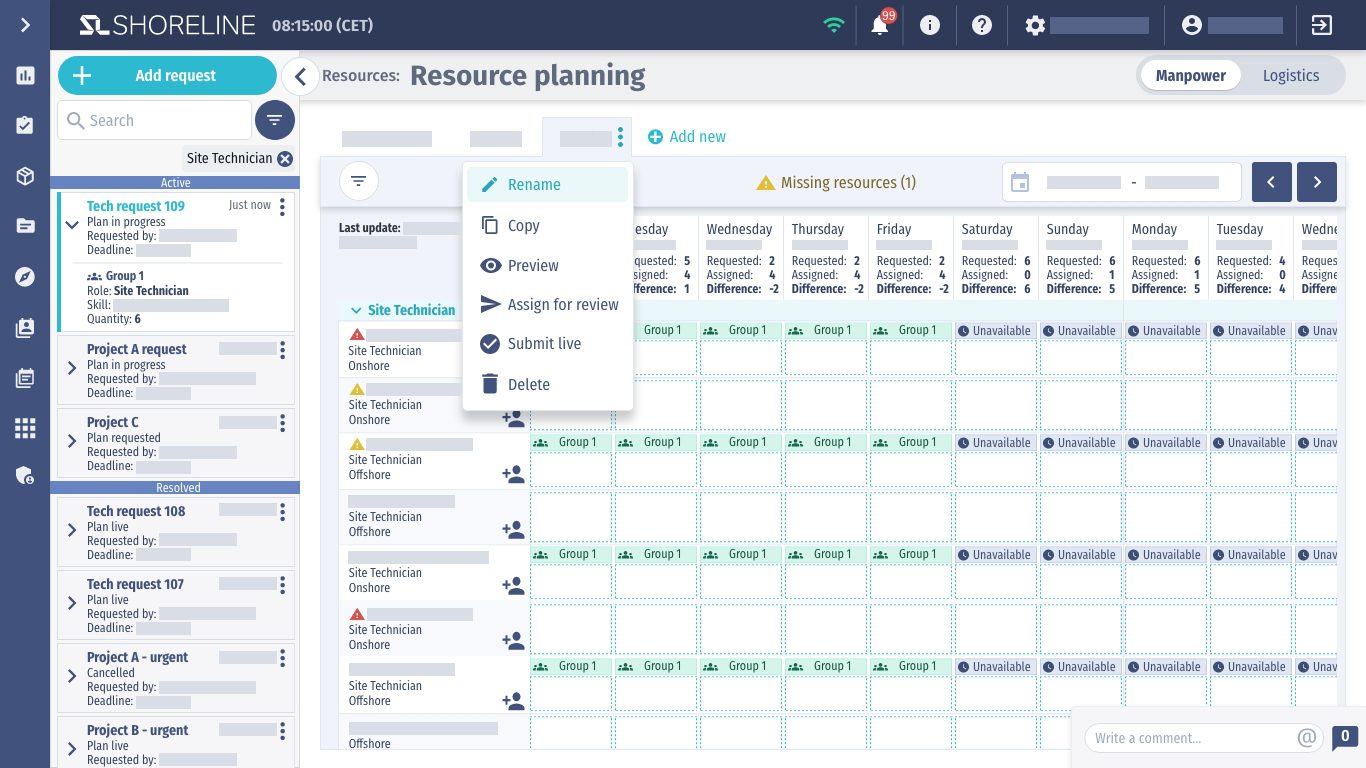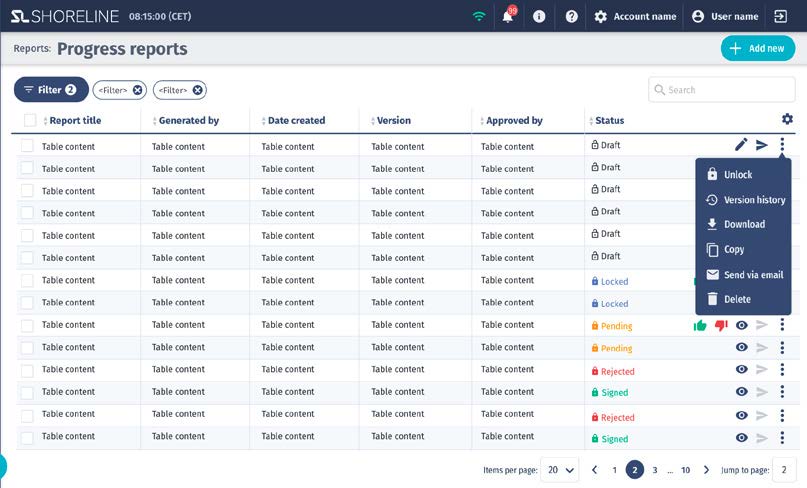First off, maintaining a wind farm is no walk in the park. Imagine having to keep track of hundreds of turbines, both on land and way out at sea. Each one has its own schedule for check-ups, repairs, and making sure it’s running smoothly. Plus, there’s the challenge of making sure the right people with the right skills are in the right place at the right time. And if that wasn’t enough, all of this planning and tracking often has to be done manually. Phew! It’s a lot, right?
Beyond the hype surrounding artificial intelligence (AI), Digitalization is already revolutionizing many sectors, including wind energy. With the global wind power industry needing to triple annual installations by 2030, digitalization offers significant benefits that can be a game-changer for streamlining operations for onshore and offshore wind farms.
Before we delve into some of the advantages digitalization offers to certain roles within the wind farm management landscape, we suggest you watch our introductory video. This feature provides a comprehensive overview of Shoreline Wind’s capabilities, setting the stage for exploring digital features of wind service project management.
The focus here is to shortly break down how specialized digital solutions are improving task management for 3 critical roles in this process: Resource Managers, Site Managers, and Project Planners. By implementing digital innovation to tackle specific challenges faced by each role, ensuring high availability, cost efficiency, and streamlined operations across wind farm projects.
Resource Managers: Efficiency and strategy
Core Responsibilities:
Resource Managers are instrumental in orchestrating the ballet of resources, from personnel to equipment, ensuring that everything is available when and where it’s needed. Their primary goal is to maximize resource utilization while minimizing costs, a delicate balance that requires foresight, planning, and agility.
Frustrations and challenges:
Navigating project resource management is fraught with challenges: from lacking a centralized resource data list that complicates tracking and allocation, to dealing with inflexible software that struggles with updates and document attachments. Additionally, understanding ever-changing employment statuses, roles, and project histories becomes a complex task due to inefficient systems.
- Inefficient Processes for Ensuring Data Quality: The absence of a centralized resource data list complicates the sharing of resources, detection of outdated personnel data, and tracking of project and client information, leading to inefficiencies in resource allocation and management.
- Limited overview of resource profiles: The lack of comprehensive views for resource information, difficulties in attaching documents, issues with duplicate IDs, and managing employment statuses. These limitations complicate the understanding of ever-changing employment situations, roles, and project histories.
- Training and Certification Tracking: Cumbersome processes for tracking and sharing training and certification statuses, along with varying client requirements, reflect the broader challenges of managing resource qualifications in a way that meets diverse client needs.
- Gap Analysis and Forecasting: The inadequacy of tools for assessing resource availability and forecasting needs leads to inefficiencies in planning, underscoring the challenges in tracking and allocating resources effectively.
These issues not only slow operations but also diminish transparency and accountability in resource management.
Feature Suggestions for Digital Process Optimization

- Advanced Project-Level Long-Term Planning: Facilitating the strategic planning of project costs and availability of resources over the long term. These tools offer a granular view of future operations, allowing for adjustments that optimize cost efficiency and resource allocation.
- Digital Overview of Training & Certification: Streamlining the data quality of training courses, skills and certifications to ensure personnel are always qualified to meet the demands of their roles. This digital approach not only simplifies administration but also enhances compliance and safety standards across projects.
- Gantt Chart Integration for Visual Planning: The integration with Gantt charts provides a visual representation of project timelines and resource allocations, making it easier to identify potential bottlenecks and adjust plans proactively.
Site Managers: The On-Ground Visionaries
Core Responsibilities:
Site Managers ensure the smooth execution of construction and service operations on the ground. They are the linchpins in maintaining project timelines, overseeing the quality of work, and ensuring safety protocols are followed, all while reporting progress and any delays to stakeholders.
Frustrations and Challenges:
For Site Managers, overseeing project sites comes with its unique set of challenges and frustrations that can hamper both efficiency and effectiveness:
- Limited Project Progress Visibility: A lack of clear insight into project progress, delays, and their underlying causes makes it difficult to manage timelines and expectations.
- Visibility of Connected Objects: Struggling with the visibility of connected objects like components, subassemblies, and assets in loadouts complicates logistics and planning.
- Time-Consuming Manual Reporting: The preparation and submission of Daily Progress Reports (DPRs) are overly time-consuming, diverting time away from on-site management activities.
- Repetitive Resource Requests: Frequently having to request the correct resources due to initial inaccuracies or changes can be repetitive and frustrating, impacting project timelines.
These frustrations not only impede the smooth operation of projects but also place additional stress on Site Managers, who play a critical role in ensuring project success.
Feature Suggestions for Digital Process Optimization:

- Comprehensive Work Package and Personnel Tracking: Digital solutions offer Site Managers a bird’s-eye view of work packages and personnel movement, enabling them to manage tasks more efficiently and respond to issues in real-time.
- Digital Progress Reporting: The ability to digitally receive and sign off on progress reports streamlines communication, cutting down the time needed to inform back office teams and clients. This immediacy ensures that all stakeholders are always in the loop, enhancing project transparency and accountability.
- Mobile App: Simplify Time Registration by logging hours directly on work orders with our user-friendly mobile app, streamlining time registration for enhanced efficiency
Project Planners: Architects of Operational Harmony
Core Responsibilities:
Project planners are tasked with the critical role of crafting work schedules and allocating the appropriate personnel and logistics to wind farm projects. Their expertise lies in anticipating the needs of each project and matching them with available resources to ensure operational fluency.
Challenges and Frustrations:
Project planners face a multifaceted array of operational challenges that impede their daily planning efficiency:
- Manual Personnel Tracking: The need to manually track both the location and competencies of personnel consumes significant time and detracts from strategic planning tasks, and affecting the allocation of the right skills to the right tasks
- Repetitive Re-scheduling: The planners frequently engage in the tedious process of re-scheduling personnel and logistics due to unforeseen issues or last-minute adjustments.
- Inadequate Technology Landscape: Work management tools often fail to meet the planners’ needs, hindering efficient planning and execution of tasks.
- Connectivity Issues: Unreliable internet connectivity on-site or aboard vessels limits their ability to communicate effectively with on-site teams and adapt plans dynamically.
These challenges highlight the necessity for technological improvements, streamlined communication channels, and more efficient processes to support the critical work of Resource and Site Planners.
Features Suggestions for Digital Process Optimization:

- Automated Planning of Resources: Streamline short and long-term planning for personnel, logistics, and work orders. Schedule personnel, vessel, transport, and crane work in one click based on resource availability,
- Visual Manpower Work Plans: Simplify manpower planning by downloading comprehensive plans for effortless gap analysis and a clear overview of personnel scheduling. Assign personnel to work orders based on their qualifications and certificates
- Offline Capability and Data Integrations: Seamlessly work in offline environments and integrate with leading wind platforms such as SAP, Planisware, IAMWind, MS Projects, Primavera, WINDA (certifications), and STORMGEO.
A Digitally Enhanced Future for Wind Service Project Management
The shift towards digitalization in the wind industry represents a significant advancement in wind service project management, promising enhanced efficiency, sustainability, and safety. At Shoreline Wind, we’re dedicated to assisting in leading this digital transformation, ensuring wind projects remain at the forefront of operational excellence.
Join us as we harness the power of digital solutions to set new benchmarks in the wind energy sector. Together, let’s turn the winds of change into digital innovation. 🌍

